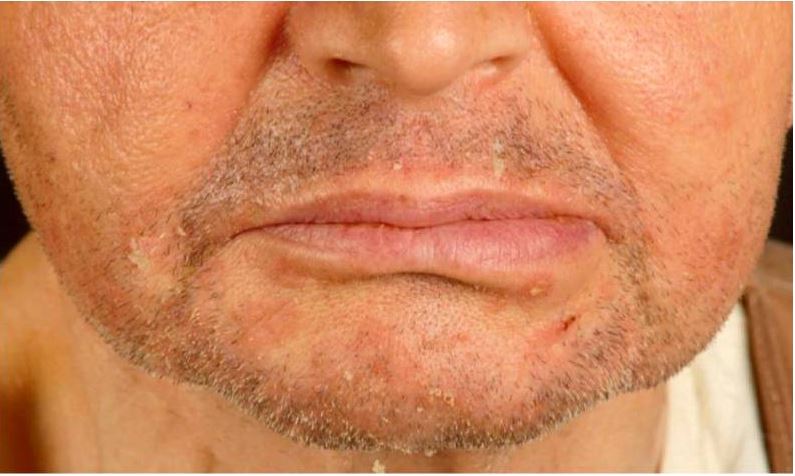Playlist
Show Playlist
Hide Playlist
Derma Case: 58-year-old Man with a Lesion on the Tip of His Nose
-
Slides Dysplastic and Malignant Skin Lesions.pdf
-
Reference List Dermatology.pdf
-
Download Lecture Overview
00:03 I think we've wrapped up that case. 00:05 She's certainly going to need a biopsy to definitively identify this lesion and then decide what type of tumor she has and how to proceed. 00:14 Let's move on to another case now. 00:17 This is a 58-year-old farmer with a past medical history of diabetes and hypertension who's presenting with a lesion right on the tip of his nose as shown here. 00:26 Now, he thought it was a pimple but he's noticed it growing over the past six months denies any pruritus. 00:33 Social and family history: he's a non-smoker. 00:35 He spends, again, most of his day in sun-exposed areas. 00:39 Review of systems is unrevealing. 00:41 Initial vitals, likewise unrevealing. 00:44 Now again, I want you to try and describe this skin lesion without help from me. 00:52 The way I would describe this again, this is a person with fair complexion. 00:56 There is a single 1.5 centimeter dome-shaped, pearly translucent papule on the tip of the nose with visible telangiectasias. 01:08 Which of the following is the most likely diagnosis? Some of the same characters we looked at before: melanoma, keratoacanthoma which we haven't talked about yet seborrheic keratosis, and then the non-melanoma skin cancers: basal and squamous cell carcinoma. 01:24 Now, you might be thinking melanoma that doesn't really look like a melanoma on the tip of his nose. 01:30 But keep in mind, there are several different subtypes of melanoma including the nodular subtype depicted here that could certainly be what he's got on his nose. 01:39 I think we have to keep that on our differential and only a biopsy will really give us the answer for that one. 01:45 It's also important to keep in mind epidemiology here. 01:50 Melanoma skin cancers only represent 2% of skin cancers and contrast basal cell and squamous non-melanoma skin cancers they are the vast majority of skin cancers. 02:02 From a probability standpoint, melanoma is probably not what's going on here. 02:05 But nonetheless, it's such a severe diagnosis especially if it's a nodular type which has that vertical growth phase. 02:14 We have to be mindful of that and look forward on biopsy. 02:18 But let's talk about keratoacanthoma here for a moment which is not really a skin cancer per se. 02:24 It's been variably described as either a pseudocancer or at worst, a low-grade malignancy. 02:31 It usually is on the face, as is the case in our patient. 02:34 It occurs in elderly patients over the age of 50. 02:37 It does have an association with HPV, though not uniformly present. 02:42 One of the unusual things about this lesion is that it does have a rapid growth phase. 02:47 You can be very concerned that it could be cancer because over the span of weeks you could go from having a tiny, tiny little papule to something that could be a centimeter or two or even three in size. 02:57 Also interestingly, it can spontaneously resolve. 03:00 It's a very unusual type of condition and something to be aware of. 03:06 It mimics squamous cell carcinoma in that way the way that it appears and the way that it can grow. 03:12 It has again a nodular, dome-shaped, central keratotic plug. 03:17 Similar to what we're seeing in our patient though the central keratotic plug is not something that was described on exam and not something that we're seeing. 03:25 Without that keratinized central plug I think we can take keratoacanthoma off the list. 03:31 Now here again, we're looking at seborrheic keratosis. 03:34 This again has this characteristic stuck-on type of appearance and it's often in not sun-exposed areas. 03:42 Our patient has this lesion right on the tip of his nose. 03:45 It's got those telangiectasias. 03:47 It's more of a reddish coloration. 03:49 I don't think seborrheic keratosis is where we're going here. 03:53 Let's leave that one off the list and move on to the next one.
About the Lecture
The lecture Derma Case: 58-year-old Man with a Lesion on the Tip of His Nose by Stephen Holt, MD, MS is from the course Neoplasms of the Skin.
Included Quiz Questions
Which of the following skin lesions is suggestive of basal cell carcinoma?
- A pearly nodule with visible telangiectasias
- A scaly, itchy patch over the forehead
- A salmon-colored papule over the knee
- A scaly, itchy, oozing plaque over the cheek
- A brown-colored nodule with an irregular border
Which of the following is true regarding keratoacanthoma?
- It grows rapidly and resolves spontaneously.
- It mostly affects adolescents.
- It appears as tender pustules.
- It is not associated with HPV.
- It commonly transforms into melanoma.
Customer reviews
5,0 of 5 stars
| 5 Stars |
|
5 |
| 4 Stars |
|
0 |
| 3 Stars |
|
0 |
| 2 Stars |
|
0 |
| 1 Star |
|
0 |




